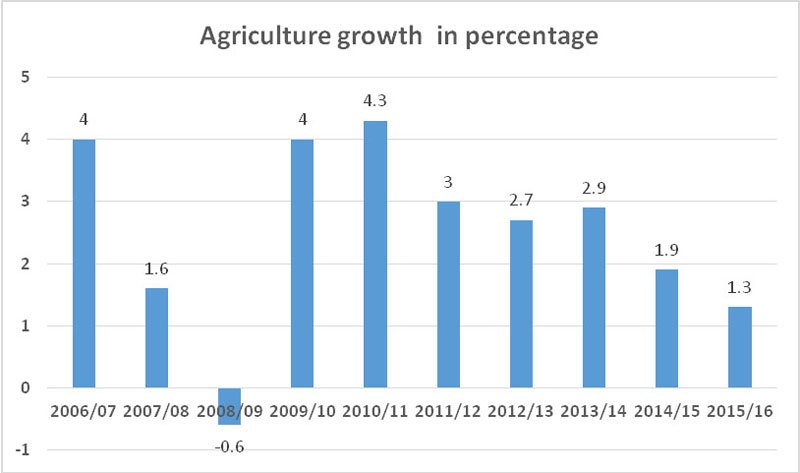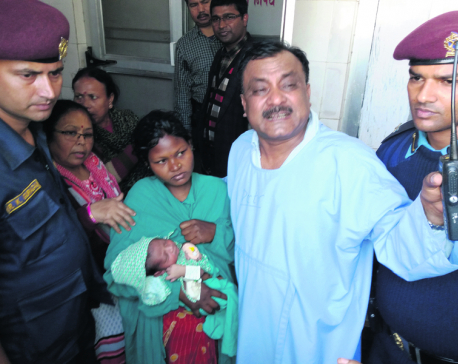
OR

Lack of strict norms on land use has led to haphazard location of settlements and industries on fertile lands
Nepal, a least developed country, relies heavily on foreign aid for agriculture development. This sector contributes one third of our Gross Domestic Product and employs 60 percent of country’s total labor force. So agriculture is the foundation of our economy, the main source of food, income and employment.
Rice is the most important cereal crop in Nepal, followed by maize, wheat, millet and barley.
However, the growth of these vital food grains has either decreased or been stagnant for over a decade.
Overall agriculture growth over the past decade was lowly 2.5 percent (see the table alongside). In this time cereal production was inadequate to meet increasing needs of a growing population. But at the same time production of vegetables, fruits, spices, and meat and milk products significantly improved.
Multiple factors have contributed to this slow cereal production, including political instability, droughts, floods, earthquakes and paucity of production inputs. Though there is currently only a small gap between food production and food requirement at the national level, the number of food-deficit districts is 31, out of 75 districts.
There has been rapid growth, both in production and marketing, of vegetable sector in over the past decade. Per capita vegetable consumption has also increased to 105 kg today from 60 kg a decade ago. Yet fruit production lags far behind vegetable and potato production.
Production of milk and meat has improved but not enough to meet the growing demand. On average, a Nepali consumes 11.15 kg of meat in a year. But despite the growth in livestock sector, Nepal is still far behind other developing countries in per capita meat and milk consumption. For instance, according to the Food and Agriculture Organization, Nepal’s per capita milk consumption of 52 liters a year is far below the global average of around 100 liters a year. A human being needs at least 90 liters of milk a year to meet his basic nutrition need.
Productive lands are a prerequisite for food sufficiency. But lack of strict norms on land use has led to haphazard location of settlements and industries on fertile lands. According to 2011 agriculture census, the area of agricultural land has decreased by 129,000 ha within the 10-year period between 2001 to 2011 due to the steady encroachment of agricultural land for non-agricultural purposes.
Further, Nepal faces a number of problems over soil fertility such as imbalanced use of fertilizers, fast cropping in commercial pockets, deforestation, encroachment of forest lands and destruction of soil by natural calamities.
Rivers have damaged huge swathes of agricultural lands over the past 10 years. Around 45.5 percent and four percent of the country’s land area is affected by water erosion and wind erosion respectively. Moreover, farm sizes are small, land is fragmented and there is no land management to speak of.
Irrigation, roads, electricity and agricultural markets along with easy cold storage and packing facilities will enhance comparative advantage of Nepali products. In this context, the Agriculture Perspective Plan (1995-2014) had put the emphasis on agricultural roads and rural electricity. In the later phase of APP, which coincided with a decade of republican polity, significant progress has been made in rural road infrastructure and irrigation expansion. However, most of these rural roads are seasonal and irrigation is monsoon-based. No wonder our agricultural commodities are not competitive.
Investment in agricultural research is low. There is weak coordination among central, regional and district level agencies related to agriculture. Quality professionals and youth farmers are leaving the country for better opportunities. Thus the overall performance of agriculture in the first decade of republican politics has been sub-par.
But there are some silver linings too. Agribusiness and commercial agriculture are growing. So are poultry and dairy processing industries. Private sector involvement has boosted productivity. Poultry production now has a highly commercial profile thanks to private investment. Tea, coffee, medicinal plants, flowers and vegetable seed productions have shown satisfactory progress. Tea and coffee production has, alone, grown between 15 and 30 percent a year since 1996.
There are over 5,000 agricultural cooperatives (mostly dealing with dairy products, tea, coffee, honey and citrus fruits). Growing adoption of information and communication technology, with more than 75 percent of the population now having an access to telephone, is also boosting overall agriculture development. Youth migrants are returning with money and skills and starting commercial agriculture. The challenge before the country right now is to institutionalize these positive gains.
bhairabr@gmail.com
You May Like This

US stocks rally; Dow surges 669, clawing back lost ground
March 27: News that the U.S. and China are open to negotiating to avert a trade war put investors in a... Read More...

Zlatan dethroned after a decade as Sweden's best player
STOCKHOLM, Nov 21: Zlatan Ibrahimovic’s unbroken ten-year run as Sweden’s best player came to an end on Monday when FC... Read More...

New-born lost from Narayani Sub-regional Hospital found after two days
BIRGUNJ, Feb 6: A newborn baby, who had disappeared from Birgunj-based Narayani Sub-regional Hospital, has been recovered from Belwa of Parsa... Read More...










Just In
- NRB introduces cautiously flexible measures to address ongoing slowdown in various economic sectors
- Forced Covid-19 cremations: is it too late for redemption?
- NRB to provide collateral-free loans to foreign employment seekers
- NEB to publish Grade 12 results next week
- Body handover begins; Relatives remain dissatisfied with insurance, compensation amount
- NC defers its plan to join Koshi govt
- NRB to review microfinance loan interest rate
- 134 dead in floods and landslides since onset of monsoon this year









Leave A Comment